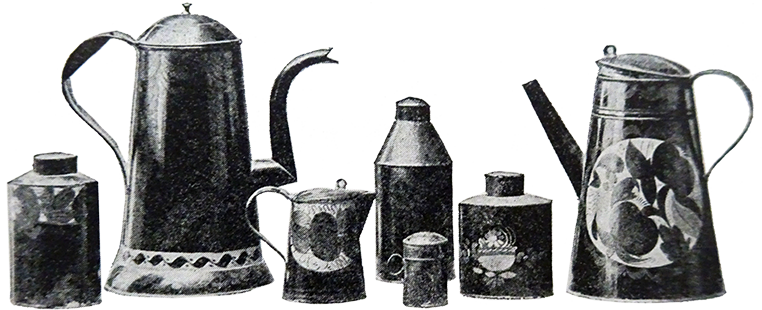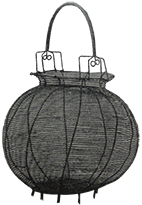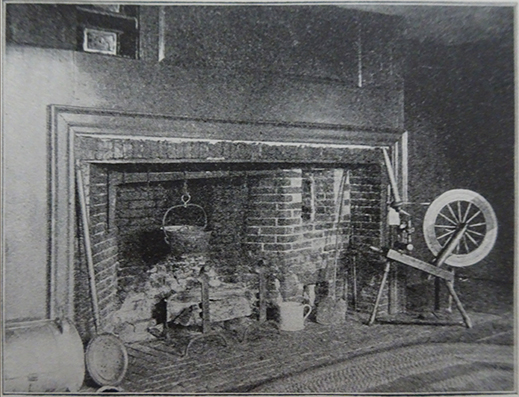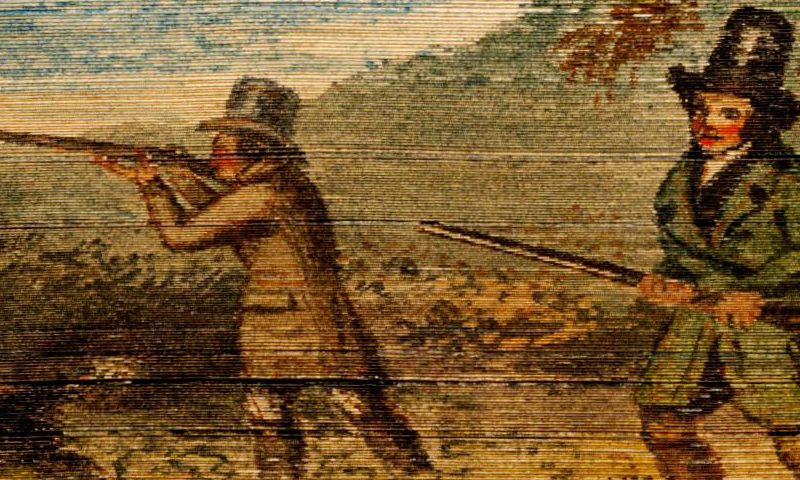
THE KITCHEN FIRESIDE, from Home Life in Colonial Days, by Alice Morse Earle, 1898
The kitchen in all the farmhouses of all the colonies was the most cheerful, homelike, and attractive room in the house; indeed, it was in town houses as well. The walls were often bare, the rafters dingy; the windows were small, the furniture meagre; but the kitchen had a warm, glowing heart that spread light and welcome, and made the poor room a home. In the houses of the first settlers the chimneys and fireplaces were vast in size, sometimes so big that the fore-logs and back-logs for the fire had to be dragged in by a horse and a long chain; or a hand-sled was kept for the purpose. Often there were seats within the chimney on either side. At night children could sit on these seats and there watch the sparks fly upward and join the stars which could plainly be seen up the great chimney-throat.
But as the forests disappeared under the waste of burning for tar, for potash, and through wanton clearing, the fireplaces shrank in size; and Benjamin Franklin, even in his day, could write of “the fireplaces of our fathers.”
The inflammable catted chimney of logs and clay, hurriedly and readily built by the first settlers, soon gave place in all houses to vast chimneys of stone, built with projecting inner ledges, on which rested a bar about six or seven or even eight feet from the floor, called a lug-pole (lug meaning to carry) or a back-bar; this was made of green wood, and thus charred slowly—but it charred surely in the generous flames of the great chimney heart. Many annoying, and some fatal accidents came from the collapsing of these wooden back-bars. The destruction of a dinner sometimes was attended with the loss of a life. Later the back-bars were made of iron. On them were hung iron hooks or chains with hooks of various lengths called pothooks, trammels, hakes, pot-hangers, pot-claws, pot-clips, pot-brakes, pot-crooks. Mr. Arnold Talbot, of Providence, Rhode Island, has folding trammels, nine feet long, which were found in an old Narragansett chimney heart. Gibcrokes and recons were local and less frequent names, and the folks who in their dialect called the lug-pole a gallows-balke called the pothooks gallows-crooks. On these hooks pots and kettles could be hung at varying heights over the fire. The iron swinging-crane was a Yankee invention of a century after the first settlement, and it proved a convenient and graceful substitute for the back-bar….
The fireplace itself sometimes went by the old English name, clavell-piece, as shown by the letters of John Wynter, written from Maine in 1634 to his English home. “The Chimney is large, with an oven at each end of him: he is so large that wee can place our Cyttle within the Clavell-piece. Wee can brew and bake and boyl our Cyttle all at once in him.” Often a large plate of iron, called the fire-back or fire-plate, was set at the back of the chimney, where the constant and fierce fire crumbled brick and split stone. These iron backs were often cast in a handsome design.
In New York the chimneys and fireplaces were Dutch in shape; the description given by a woman traveller at the end of the seventeenth century ran thus:—
“The chimney-places are very droll-like: they have no jambs nor lintell as we have, but a flat grate, and there projects over it a lum [chimney ledge] in the form of the cat-and-clay [built of sticks, coated with mixture of clay and straw] lum, and commonly a muslin or ruffled pawn around it.“
The “ruffled pawn” was a calico or linen valance which was hung on the edge of the mantel-shelf, a pretty and cheerful fashion seen in some English as well as Dutch homes.
Another Dutch furnishing, the alcove bedstead, much like a closet, seen in many New York kitchens, was replaced in New England farm-kitchens by the “turn-up” bedstead. This was a strong frame filled with a network of rope which was fastened at the bed-head by hinges to the wall. By night the foot of the bed rested on two heavy legs; by day the frame with its bed furnishings was hooked up to the wall, and covered with homespun curtains or doors. This was the sleeping-place of the master and mistress of the house, chosen because the kitchen was the warmest room in the house. One of these “turn-up” bedsteads which was used in the Sheldon homestead until this century may be seen in Deerfield Memorial Hall….
Over the fireplace and across the top of the room were long poles on which hung strings of peppers, dried apples, and rings of dried pumpkin. And the favorite resting-place for the old queen’s-arm or fowling-piece was on hooks over the kitchen fireplace.
On the pothooks and trammels hung what formed in some households the costliest house-furnishing,—the pots and kettles. The Indians wished their brass kettles buried with them as a precious possession, and the settlers equally valued them; often these kettles were worth three pounds apiece. In many inventories of the estates of the settlers the brass-ware formed an important item. Rev. Thomas Hooker of Hartford had brass-ware which, in the equalizing of values to-day, would be worth three or four hundred dollars. The great brass and copper kettles often held fifteen gallons.

The vast iron pot—desired and beloved of every colonist—sometimes weighed forty pounds, and lasted in daily use for many years. All the vegetables were boiled together in these great pots, unless some very particular housewife had a wrought-iron potato-boiler [picture] to hold potatoes or any single vegetable in place within the vast general pot.
Chafing-dishes and skimmers of brass and copper were also cheerful discs to reflect the kitchen firelight.
Very little tin was seen, either for kitchen or table utensils. Governor Winthrop had a few tin plates, and some Southern planters had tin pans, others “tynnen covers.” Tin pails were unknown; and the pails they did own, either of wood, brass, or other sheet metal, had no bails, but were carried by thrusting a stick through little ears on either side of the pail. Latten ware was used instead of tin; it was a kind of brass. A very good collection of century-old tinware is shown in the illustration. By a curious chance this tinware lay unpacked for over ninety years in the attic loft of a country warehouse, in the packing-box, just as it was delivered from an English ship at the close of the Revolution. The pulling down of the warehouse disclosed the box, with its dated labels. The tin utensils are more gayly lacquered than modern ones, otherwise they differ little from the tinware of to-day.
There was one distinct characteristic in the house-furnishing of olden times which is lacking to-day. It was a tendency for the main body of everything to set well up, on legs which were strong enough for adequate support of the weight, yet were slender in appearance. To-day bureaus, bedsteads, cabinets, desks, sideboards, come close to the floor; formerly chests of drawers, Chippendale sideboards, four-post bedsteads, dressing-cases, were set, often a foot high, in a tidy, cleanly fashion; thus they could all be thoroughly swept under. This same peculiarity of form extended to cooking-utensils. Pots and kettles had legs, as shown in those hanging in the slave-kitchen fireplace; gridirons had legs, skillets had legs; and further appliances in the shape of trivets, which were movable frames, took the place of legs. The necessity for the stilting up of cooking-utensils was a very evident one; it was necessary to raise the body of the utensil above the ashes and coals of the open fireplace. If the bed of coals and burning logs were too deep for the skillet or pot-legs, then the utensil must be hung from above by the ever-ready trammel.
Often in the corner of the fireplace there stood a group of trivets, or three-legged stands, of varying heights, through which the exactly desired proximity to the coals could be obtained.

Even toasting-forks, and similar frail utensils of wire or wrought iron, stood on tall, spindling legs, or were carefully shaped to be set up on trivets. They usually had, also, long, adjustable handles, which helped to make endurable the blazing heat of the great logs. All such irons as waffle-irons [picture] had far longer handles than are seen on any cooking-utensils in these days of stoves and ranges, where the flames are covered and the housewife shielded. Gridirons had long handles of wood or iron, which could be fastened to the shorter stationary handles….
An accompaniment of the kitchen fireplace, found, not in farmhouses, but among luxury-loving town-folk, was the plate-warmer. They are seldom named in inventories, and I know of but one of Revolutionary days…. Similar ones are manufactured to-day; the legs, perhaps, are shorter, but the general outline is the same.
An important furnishing of every fireplace was the andirons. In kitchen fireplaces these were usually of iron, and the shape known as goose-neck were common. Cob irons were the simplest form, and merely supported the spit; sometimes they had hooks to hold a dripping-pan. A common name for the kitchen andirons was fire-dogs; and creepers were low, small andirons, usually used with the tall fire-dogs. The kitchen andirons were simply for use to help hold the logs and cooking-utensils. But other fireplaces had handsome fire-dogs of copper, brass, or cut steel, cast or wrought in handsome devices. These were a pride and delight to the housewife.
A primitive method of roasting a joint of meat or a fowl was by suspending it in front of the fire by a strong hempen string tied to a peg in the ceiling, while some one—usually an unwilling child—occasionally turned the roast around. Sometimes the sole turnspit was the housewife, who, every time she basted the roast, gave the string a good twist, and thereafter it would untwist, and then twist a little again, and so on until the vibration ceased, when she again basted and started it. As the juices sometimes ran down in the roast and left the upper part too dry, a “double string-roaster” was invented, by which the equilibrium of the joint could be shifted. A jack was a convenient and magnified edition of the primitive string, being a metal suspensory machine. A still further glorification was the addition of a revolving power which ran by clockwork and turned the roast with regularity; this was known as a clock-jack…. A smoke-jack was run somewhat irregularly by the pressure of smoke and the current of hot air in the chimney. These were noisy and creaking and not regarded with favor by old-fashioned cooks.
We are apt to think of the turnspit dog as a creature of European life, but we had them here in America—little low, bow-legged, patient souls, trained to run in a revolving cylinder and keep the roasting joint a-turn before the fire. Mine host Clark of the State House Inn in Philadelphia in the first half of the eighteenth century advertised in Benjamin Franklin’s Pennsylvania Gazette that he had for sale “several dogs and wheels, much preferable to any jacks for roasting any joints of meat.” I hope neither he nor any one else had many of these little canine slaves.
A frequent accompaniment of the kitchen fireplace in the eighteenth century, and a domestic luxury seen in well-to-do homes, was the various forms of the “roasting-kitchen,” or Dutch oven. These succeeded the jacks; they were a box-like arrangement open on one side which when in use was turned to the fire. Like other utensils of the day, they often stood up on legs, to bring the open side before the blaze. A little door at the back could be opened for convenience in basting the roast. These kitchens came in various sizes for roasting birds or joints, and in them bread was occasionally baked. The bake-kettle, which in some communities was also called a Dutch oven, was preferred for baking bread. It was a strong kettle, standing, of course, on stout, stumpy legs, and when in use was placed among the hot coals and closely covered with a strong metal, convex cover, on which coals were also closely heaped. Such perfect rolls, such biscuit, such shortcake, as issued from the heaped-up bake-kettle can never be equalled by other methods of cooking.
When the great stone chimney was built, there was usually placed on one side of the kitchen fireplace a brick oven which had a smoke uptake into the chimney—and-an ash-pit below. The great door was of iron. This oven was usually heated once a week. A great fire of dry wood, called oven wood, was kindled within it and kept burning fiercely for some hours. This thoroughly heated all the bricks. The coals and ashes were then swept out, the chimney draught closed, and the oven filled with brown bread, pies, pots of beans, etc. Sometimes the bread was baked in pans, sometimes it was baked in a great mass set on cabbage leaves or oak leaves. In some towns an autumn harvest of oak leaves was gathered by children to use throughout the winter. The leaves were strung on sticks. This gathering was called going a-leafing.
By the oven side was always a long-handled shovel known as a peel or slice, which sometimes had a rack or rest to hold it; this implement was a necessity in order to place the food well within the glowing oven. The peel was sprinkled with meal, great heaps of dough were placed thereon, and by a dexterous twist they were thrown on the cabbage or oak leaves. A bread peel was a universal gift to a bride; it was significant of domestic utility and plenty, and was held to be luck-bearing. On Thanksgiving week the great oven had a fire built in it every morning, and every night it was well filled and closed till morning.
On one side of the kitchen often stood a dresser, on which was placed in orderly rows the cheerful pewter and scant earthenware of the household:—
“—the room was bright
With glimpses of reflected light,
From plates that on the dresser shone.”
In Dutch households plate-racks, spoon-racks, knife-racks,—all hanging on the wall,—took the place of the New England dresser.
In the old Phillips farmhouse at Wickford, Rhode Island, is a splendid chimney over twenty feet square. So much room does it occupy that there is no central staircase, but little winding stairs ascend at three corners of the house. In the vast fireplace an ox could literally have been roasted. On each chimney-piece are hooks to hang firearms, and at one side curious little drawers are set for pipes and tobacco. In some Dutch houses in New York these tobacco shelves are in the entry, over the front door, and a narrow flight of three or four steps leads up to them. Hanging on a nail alongside the tobacco drawer, or shelf, would usually be seen a pipe-tongs, or smoking-tongs. They were slender little tongs, usually of iron or steel; with them the smoker lifted a coal from the fireplace to light his pipe. The tongs owned and used by Captain Joshua Wingate, of Hampton, New Hampshire, who lived from 1679 to 1769, are here shown. The handle is unlike any other I have seen, having one end elongated, knobbed, and ingeniously bent S-shaped into convenient form to press down the tobacco into the bowl of the pipe. Other old-time pipe-tongs were in the form of lazy-tongs. A companion of the pipe-tongs on the kitchen mantel was what was known as a comfortier—a little brazier of metal in which small coals could be handed about for pipe-lighting. An unusual luxury was a comfortier of silver. These were found among the Dutch settlers.
The Pennsylvania Germans were the first to use stoves. These were of various shapes. A curious one, seen in houses and churches, was of sheet-metal, box-shaped; three sides were within the house, and the fourth, with the stove door, outside the house. Thus what was really the back of the stove projected into the room, and when the fire was fed it was necessary for the tender to go out of doors. These German stoves and hot-air drums, which heated the second story of the house, were ever a fresh wonder to travellers of English birth and descent in Pennsylvania. There is no doubt that their evident economy and comfort suggested to Benjamin Franklin the “New Pennsylvania Fireplace,” which he invented in 1742, in which both wood and coal could be used, and which was somewhat like the heating apparatus which we now call a Franklin stove, or heater.
Thus German settlers had, in respect to heating, the most comfortable homes of all the colonies. Among the English settlers the kitchen was, too often, the only comfortable room in the house in winter weather. Indeed, the discomforts and inconveniences of a colonial home could scarcely be endured to-day; of course these culminated in the winter time, when icy blasts blew fiercely down the great chimneys, and rattled the loosely fitting windows. Children suffered bitterly in these cold houses. The rooms were not warm three feet away from the blaze of the fire. Cotton Mather and Judge Samuel Sewall both tell, in their diaries, of the ink freezing in their pens as they wrote within the chimney-side. One noted that, when a great fire was built on the hearth, the sap forced out of the wood by the flames froze into ice at the end of the logs. The bedrooms were seldom warmed, and had it not been for the deep feather beds and heavy bed-curtains, would have been unendurable. In Dutch and some German houses, with alcove bedsteads, and sleeping on one feather bed, with another for cover, the Dutch settlers could be far warmer than any English settlers, even in four-post bedsteads curtained with woollen….
Many of our New England poets have given us glimpses in rhyme of the old-time kitchen. Lowell’s well-known lines are vivid enough to bear never-dying quotation:—
“A fireplace filled the rooms one side
With half a cord of wood in—
There warn’t no stoves (tell comfort died)
To bake ye to a puddin’.
“The wa’nut log shot sparkles out
Towards the pootiest—bless her!
An’ little flames danced all about
The chiny on the dresser.
“Agin the crumbly crooknecks hung,
An’ in amongst ’em rusted
The old queen’s-arm that granther Young
Fetched back from Concord busted.”
To me the true essence of the old-time fireside is found in Whittier’s Snow-Bound. The very chimney, fireplace, and hearthstone of which his beautiful lines were written, the kitchen of Whittier’s boyhood’s home, at East Haverhill, Massachusetts, is shown in the accompanying illustration. It shows a swinging crane. His description of the “laying the fire” can never be equalled by any prose:—

“We piled with care our nightly stack
Of wood against the chimney back—
The oaken log, green, huge, and thick,
And on its top the stout back-stick;
The knotty fore-stick laid apart,
And filled between with curious art
The ragged brush; then hovering near,
We watched the first red blaze appear,
Heard the sharp crackle, caught the gleam
On whitewashed wall and sagging beam,
Until the old, rude-furnished room
Burst, flower-like, into rosy bloom.”
No greater illustration of homely contentment could be shown than the following lines:—
“Shut in from all the world without,
We sat the clean-winged hearth about,
Content to let the north wind roar
In baffled rage at pane and door,
While the red logs before us beat
The frost-line back with tropic heat;
And ever, when a louder blast
Shook beam and rafter as it passed,
The merrier up its roaring draught
The great throat of the chimney laughed.
The house dog on his paws outspread
Laid to the fire his drowsy head,
The cat’s dark silhouette on the wall
A couchant tiger’s seemed to fall;
And, for the winter fireside meet,
Between the andirons’ straddling feet
The mug of cider simmered slow,
And apples sputtered in a row.
And, close at hand, the basket stood
With nuts from brown October’s woods.
What matter how the night behaved!
What matter how the north wind raved!
Blow high, blow low, not all its snow
Could quench our hearth-fire’s ruddy glow.“
Nor can the passing of years dim the ruddy glow of that hearth-fire, nor the charm of the poem. The simplicity of metre, the purity of wording, the gentle sadness of some of its expressions, make us read between the lines the deep and affectionate reminiscence with which it was written.
